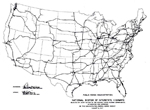The National Interstate Story
The National System of Interstate and Defense Highways was designated by the Federal-Aid Highway Act of 1956. The Act established the Highway Trust Fund as a pay-as-you-go means of federal financing (90 percent of a project's cost to 10 percent state-collected highway user taxes) to help build the Interstates.
The primary objective of the Interstate system was to build highways with four lanes and controlled access that connected principal cities, state capitals and national defense installations. The Act set the miles to be built at 41,000 miles. The Federal-Aid Highway Act of 1968 added 1,500 more miles.
The Federal-Aid Highway Act of 1956 was signed by President Dwight D. Eisenhower, a Kansan who conceived the transcontinental Interstate highway system. In 1919, then Lt. Col. Eisenhower led a military convoy on a 3,200-mile trip from Washington, D.C., to San Francisco. It took 62 days to complete the trip, convincing the future president that good highways were needed for defense and commerce.
The American Society of Civil Engineers (ASCE) has called the Dwight D. Eisenhower System of Interstate and Defense Highways one of the "Seven Wonders of the United States," an honor also bestowed on the Golden Gate Bridge, Hoover Dam, and the Panama Canal.
Visit the following pages to learn more about the National Interstate Story.










